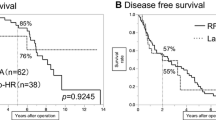Abstract.
The benefits of liver resection for patients with hepatocellular carcinoma (HCC) and concomitant liver cirrhosis have been questionable due to high rates of postoperative complications. As a result of advance in surgical techniques, along with improved perioperative management and increased knowledge of the pathophysiology of liver cirrhosis, liver resection in cirrhotic patients has become a safer surgical procedure during the 1990 s. This article introduces our techniques of parenchymal resection in patients with liver cirrhosis, avoiding inflow occlusion of the hepatic circulation by using a Cavitron Ultrasonic Surgical Aspirator (CUSA) and bipolar cautery that is equipped with a mechanism for channeling water at the point of cauterization. Analysis of survival rates showed that surgical resection was more advantageous than treatment such as percutaneous ethanol injection, although the discovery of multicentric carcinogenesis in livers with hepatitis C viral infection required us to reconsider surgical indications for HCC and concomitant liver cirrhosis.
Zusammenfassung.
Der Erfolg von Leberresektionen bei Patienten mit hepatocellulärem Carcinom (HCC), das mit einer Lebercirrhose einhergeht, war aufgrund hoher Komplikationsraten fragwürdig. Als Zeichen des Fortschritts chirurgischer Technik in Einheit mit verbessertem perioperativem Management und fundierterem Wissen um die Pathophysiologie der Lebercirrhose, wurde die Leberresektion bei cirrhotischen Patienten in den 90 er Jahren zu einer sichereren chirurgischen Maßnahme. Dieser Artikel stellt unsere Technik der parenchymatösen Resektion unter Vermeidung der Einstromocclusion vor. Hierfür wird ein Cavitron Ultrasonic Surgical Aspirator (CUSA) und eine bipolare Thermokauterisationspinzette eingesetzt, bei der an der Kauterisationsfläche durch einen Kanal eine kontinuierliche Benetzung erfolgt. Die Analyse der Überlebensdaten zeigte, dass die chirurgische Resektion interventionellen Verfahren, wie beispielsweise der percutanen Ethanolinstillation (PEI) überlegen war, obwohl die Entdeckung der multizentrischen Carcinogenese in Hepatitis C infizierten Lebern uns die chirurgischen Indikationen bei HCC und Lebercirrhose zwischenzeitlich neu überdenken ließ.
Similar content being viewed by others
Author information
Authors and Affiliations
Rights and permissions
About this article
Cite this article
Yamamoto, Y. Leberresektion bei Lebercirrhose. Chirurg 72, 784–793 (2001). https://doi.org/10.1007/s001040170106
Issue Date:
DOI: https://doi.org/10.1007/s001040170106




